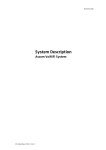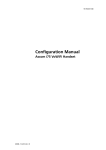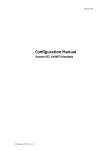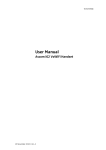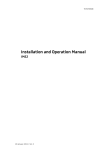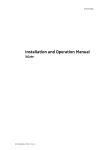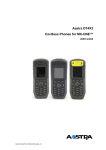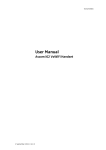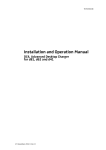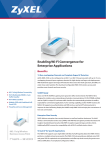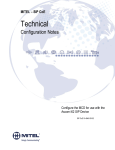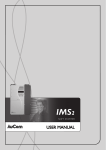Download shared phone
Transcript
TD 92468GB Function Description Shared Phones in Ascom Systems 13 December 2010 / Ver. B Function Description Shared Phones in Ascom Systems TD 92468GB Contents 1 Introduction .................................................................................................................... 1 1.1 Abbreviations and Glossary................................................................................................... 1 2 System Overview ............................................................................................................ 2 2.1 Technical Solution .................................................................................................................... 2 2.2 System Outline.......................................................................................................................... 3 2.3 System Requirements ............................................................................................................. 4 3 System Installation ........................................................................................................ 5 3.1 Physical Installation................................................................................................................. 5 3.2 Parameter Settings.................................................................................................................. 5 4 Operating Instructions................................................................................................... 6 4.1 Log On a Shared Phone........................................................................................................... 6 4.2 Log Off a Shared Phone .......................................................................................................... 6 5 Related Documents ........................................................................................................ 7 6 Document History .......................................................................................................... 8 13 December 2010 / Ver. B Function Description Shared Phones in Ascom Systems 1 TD 92468GB Introduction The shared phone feature allows a group of users to share handsets in the system and still have their own individual settings, such as volume-, alarm parameters, and local phonebook. The handset has a virtual SIM card stored apart from the handset, and the settings are retrieved to the handset when the user logs on to the system. This facilitates the management of handsets to a great extent since a user can take any handset and log on to the system. By always having a couple of extra handsets preconfigured for WLAN access, a broken handset can easily be replaced by the user himself. 1.1 Abbreviations and Glossary ESS Enhanced System Service: Unite modules that handle centralised number planning, remote connection, system supervision, fault handling, group handling, message routing, centralised logging, activity logging, and user access administration. IMS2 Integrated Wireless Messaging and Services: Unite module that enables wireless services to and from portable devices and chargers. It also includes the Device Manager. SIM Subscriber Identity Module UNS User Name Service Unite CM Unite Connectivity Manager: a Unite module that enables messaging and alarm handling in a system. It also includes the Device Manager. WinPDM Portable Device Manager Windows Version: a software application for initial configuration of the VoWiFi handsets. 13 December 2010 / Ver. B 1 Function Description Shared Phones in Ascom Systems 2 TD 92468GB System Overview 2.1 Technical Solution When the handset logs on, it must authenticate itself to the IMS2/Unite CM with a password. The password is then stored in the handset until it is switched off or logged out. The IMS2/Unite CM has three authentication alternatives: “Common password”, “User server”, and “Number as password”. A common password, used for all VoWiFi handsets in the system, is recommended for personal phones. For shared phones individual passwords are recommended. When the password is accepted by the IMS2/Unite CM and the handset is found in the Device Manager, it can log on to the VoWiFi System. The handset itself must be configured as a shared phone. It must also be pre-configured for WLAN access. Individual passwords can be specified in a User Server. Otherwise, specify in the IMS2/ Unite CM that the individual call numbers are to be used. Unite CM includes a User Server. For IMS2, an ESS can work as a User Server. The IMS2 then checks with the ESS if the password is OK. Figure 1. IP Backbone / LAN User Server VoWiFi Handset Authentication/ Administration Server UNS Password OK UNS Password OK Device Manager IMS2/Unite CM ESS/Unite CM Figure 1. Individual passwords specified in a User Server When the individual call number is used as password, the IMS2/Unite CM will (if the user name is correct) accept any number, but the handset can only log on to the VoWiFi System if the number is defined in the Device Manager. Figure 2. IP Backbone / LAN VoWiFi Handset Authentication/ Administration Server OK UNS Password Device Manager IMS2/Unite CM Figure 2. Individual call number used as password 13 December 2010 / Ver. B 2 Function Description Shared Phones in Ascom Systems TD 92468GB The IMS2/Unite CM is used for handset management and stores all parameters and settings. These parameters and settings are loaded to the handset upon logon. The parameters are synchronised if updated in either the handset or in the IMS2/Unite CM. Figure 3. IP Backbone / LAN 7 932 Authentication/ Administration Server VoWiFi Handsets 933 0 Virtual SIM 9327 Virtual SIM 9330 IMS2/Unite CM Figure 3. The IMS2/Unite CM stores all handset parameters and settings 2.2 System Outline Figure 4. WinPDM AP AP equ on r cati enti h Aut IP-PBX Password Ok? Virtual SIM (a2) Ok wed allo ual Virt SIM 7 932 Virtual SIM Virtual SIM ESS/Unite CM 2 n atio tic hen Aut (a1) ) est 1(a IP Backbone / LAN 3 IMS2/Unite CM Virtual SIM 9327 Figure 4. Shared phone logon procedure When the handset is logged out or powered-up, the logon prompt will be shown in the display. The user needs to enter the password at each logon, and the password is then sent together with an authentication request to the IMS2/Unite CM. If a User Server is involved, the IMS2/Unite CM passes on the request to the User Server, and if the password is registered in the User Server, a confirmation is sent back to the IMS2/Unite CM. The IMS2/Unite CM accepts the authentication and logs on the handset. When the handset is found in the Device Manager, the IMS2/Unite CM sends the personal parameters, and the handset can be used in the VoWiFi System. The IMS2/Unite CM also synchronizes the parameters between the handset and the Device Manager. If parameters are changed in the handset by a user after logged on, they will be stored in the IMS2/Unite CM. A “Logon failed” message will, after a timeout, be shown in the display if the handset does not get any response from the Device Manager. 13 December 2010 / Ver. B 3 Function Description Shared Phones in Ascom Systems TD 92468GB If the number is occupied, that is already logged on, the logon result differs depending on the authentication method used. If common password or number as password is used, the handset will get a “Fail login” message after a timeout. If a User Server is used, the handset will be allowed to log on, and the already logged on handset will be logged out. When the handset is logged out or switched off, the message list and call list in the handset disappears and will be empty when a new user logs on to the handset. 2.3 System Requirements • • • • • i62 VoWiFi Handset version 2.1.19 or later i75 VoWiFi Handset version 1.2.20 or later IMS2 version 2.62 or later Unite CM version 2.03 or later ESS version 2.15 or later (optional) 13 December 2010 / Ver. B 4 Function Description Shared Phones in Ascom Systems 3 TD 92468GB System Installation 3.1 Physical Installation We assume that all devices in the VoWiFi System are installed, and that the configuration needed is performed in accordance to the information and recommendations in the documentation. This includes third-party documentation together with applicable configuration notes as well as the documents in 5 Related Documents on page 7. 3.2 Parameter Settings Handset Settings in the IMS2/Unite CM • • The handsets must be configured to be shared, which means that the user profile must have the “Phone mode” parameter set to “Shared”. If the user is configured as personal (that is not shared), the handset will become a personal phone upon first log on. Each VoWiFi handset must be programmed with the IP address of the IMS2/Unite CM to be able to log on to the IMS2/Unite CM. How to programme the handset is described in the Installation and Operation Manual IMS2, TD 92586GB. Detailed information on parameters can be found in the Configuration Manual i62 VoWiFi Handset, TD 92675GB, and the Configuration Manual i75 VoWiFi Handset, TD 92431GB. IMS2/Unite CM • • • Either “User server” or “Number as password” needs to be selected as authentication alternative. If “User server” is selected in IMS2, continue below. The operating mode for the User Name Service (UNS) must be set to “forwarding”. The IP address of the User Server (the ESS which has the users defined) must be set as IP address of forward destination UNS and as User Server IP address. For detailed description of the configuration in the IMS2/Unite CM, refer to the Installation and Operation Manual IMS2, TD 92586GB, or Installation and Operation Manual Unite CM, TD 92735GB. ESS/Unite CM The following is only needed if “User Server” is selected as authentication alternative in the IMS2/Unite CM. For Unite CM these settings have probably already been configured, if it is used for messaging and alarm handling. • • • A category for the VoWiFi System needs to be setup, and if an ESS is used the IP address to the IMS2 needs to be specified. All shared phone numbers need to be setup in the ESS/Unite CM for the category mentioned above, and if an ESS is used they must be identical to the numbers in the IMS2. Users need to be created and attached to the phone numbers. For detailed description of the configuration in the ESS/Unite CM, refer to the Installation and Operation Manual ESS, TD 92253GB, or Installation and Operation Manual Unite CM, TD 92735GB. 13 December 2010 / Ver. B 5 Function Description Shared Phones in Ascom Systems 4 TD 92468GB Operating Instructions 4.1 Log On a Shared Phone 1 Switch the handset on. 2 Enter the user name, which in this case is the individual phone number. 3 Enter the individual password (can also be the individual phone number). Navigate using the and on the navigation key. 4 Press “Log in”. If the handset does not find the WLAN upon start-up, a “No System” screen is displayed. If the handset does not receive an IP address from the system, a “No Access” screen is displayed. 4.2 Log Off a Shared Phone 1 Press and hold the End key 2 A control question “Log off?” is displayed. Confirm by pressing “Yes”. 13 December 2010 / Ver. B . 6 Function Description Shared Phones in Ascom Systems 5 TD 92468GB Related Documents System Description Ascom VoWiFi System TD 92313GB Function Description Ascom VoWiFi System TD 92314GB System Planning Ascom VoWiFi System TD 92408GB Configuration Manual i62 VoWiFi Handset TD 92675GB User Manual i62 VoWiFi Handset TD 92599GB Quick Reference Guide i62 VoWiFi Handset TD 92597GB Configuration Manual i75 VoWiFi Handset TD 92431GB User Manual i75 VoWiFi Handset TD 92319GB Quick Reference Guide i75 VoWiFi Handset TD 92320GB Data Sheet i62 VoWiFi Handset TD 92587GB Data Sheet i75 VoWiFi Handset TD 92318GB Data Sheet IMS2 TD 92585GB Data Sheet Unite CM TD 92739GB Installation and Operation Manual IMS2 TD 92586GB Installation and Operation Manual Unite CM TD 92735GB Installation and Operation Manual ESS TD 92253GB 13 December 2010 / Ver. B 7 Function Description Shared Phones in Ascom Systems 6 TD 92468GB Document History For details in the latest version, see change bars in the document. Version Date Description A 13 August 2007 First released version. B 13 December 2010 • Replaced IMS/IP-WiFi with IMS2 throughout. • Added Unite CM throughout. • Replaced PDM System Version with the Device Manager in the IMS2 throughout. • Added chapter 1.1 Abbreviations and Glossary on page 1. • Clarified that the described usage of common and personal passwords is recommended in chapter 2.1 Technical Solution on page 2. • Added i62 VoWiFi handset and updated the required versions in chapter 2.3 System Requirements on page 4. • Changed the log off procedure in chapter 4.2 Log Off a Shared Phone on page 6. 13 December 2010 / Ver. B 8












